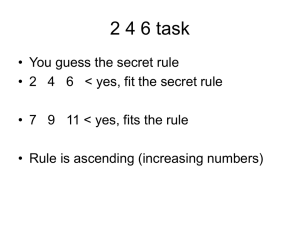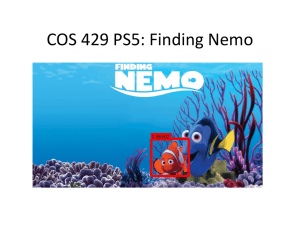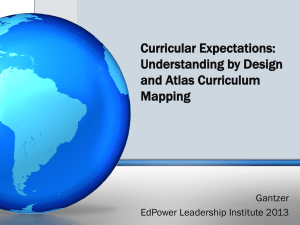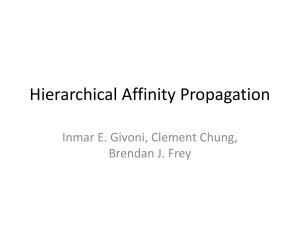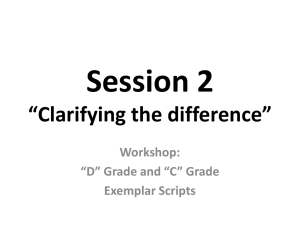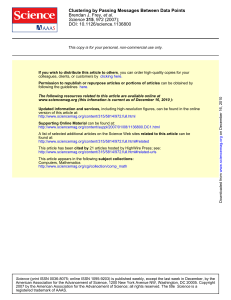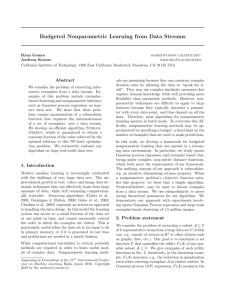Clustering by Passing Messages Between Data Points
advertisement
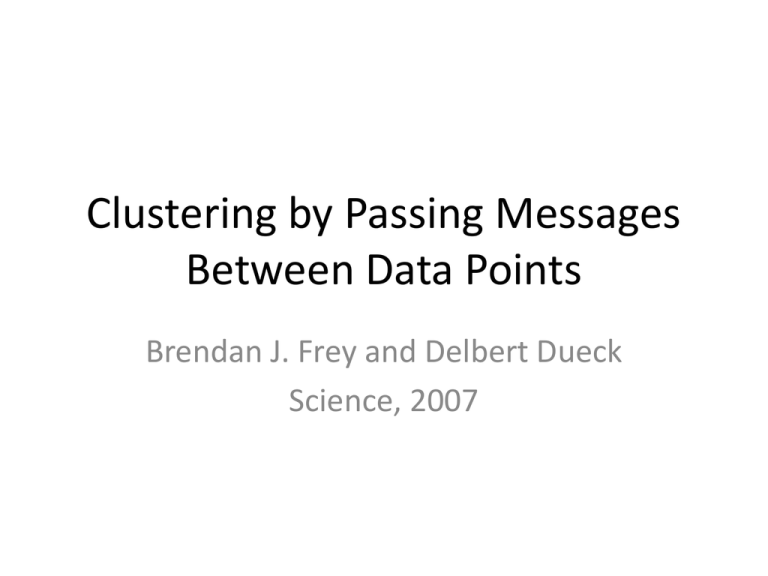
Clustering by Passing Messages Between Data Points Brendan J. Frey and Delbert Dueck Science, 2007 Outline • • • • Introduction Method Description Experiments Conclusion 2 Introduction • Clustering: based on a measure of similarity to cluster data. • Exemplar: the centers are selected from actual data points. 3 Introduction • A common approach: k-centers clustering. • It’s sensitive to the initial selection of exemplars. 4 Introduction • In k-means algorithm, the number of exemplars need be specified beforehand. • How to apply clustering if we don’t know the number of exemplars? 5 Method Description • A new approach: affinity propagation. • We view each data point as a node in a network and consider all data points as potential exemplars. 6 Similarity and Preference • Affinity propagation needs two information – Similarities between data points: – Preferences: • Similarity indicates how well the data point k is suited to be the exemplar for data point i. • Preference influences the number of clusters. 7 Messages exchanged • Affinity propagation recursively transmits realvalued messages along edges of the network until a good set of exemplars and clusters emerges. • The messages include: – responsibility – availability • Availabilities and responsibilities can be combined to identify exemplars. 8 Responsibility and availability • Responsibility : reflects the accumulated evidence for how well-suited point k is to serve as the exemplar for point i. From data point i to candidate exemplar point k, it takes into account other potential exemplars for point i. 9 Responsibility and availability • Availability : reflects the accumulated evidence for how appropriate it would be for point i to choose point k as its exemplar. From candidate exemplar point k to point i, it takes into account the support from other points that point k should be an exemplar. 10 How to send messages? • The availabilities are initialized to 0, means each point doesn’t decide which exemplar it belongs to. • The responsibilities are updated by: , it (For the first iteration.) If r is bigger, it means the point k is more wellsuited for point i than other exemplars k’. 11 How to send messages? • Self-responsibility : for i = k, it will be r (k , k ) s (k , k ) max s (k , k ' ) preference k ' s .t .k ' k The similarities with all other exemplars. How appropriate it would be for data point k as an exemplar itself? If r (k , k ) 0 , exemplar is more appropriate to belong to other exemplars. 12 How to send messages? • Availabilities are updated by: It’s the sum of responsibilities for supporting points i’ to exemplar k. 0 If a = 0, it means exemplar point k is more wellsuited to point i. 13 How to send messages? • If availability is less than 0, it will increase the other points’ responsibility: Availability < 0 Responsibility from data point i to exemplar k increases! 14 How to send messages? • Self-availability : for i = k, it will be How appropriate it would be for data point k as an exemplar itself? Based on the responsibilities from other data points i. 15 How to identify the cluster? • For point i, we would like to find: max a (i, k ) r (i, k ) k • If k = i, the data point i is an exemplar itself. • Otherwise, the data point k is the exemplar of point i. 16 Method Description • Each iteration of affinity propagation consisted of: – Updating all responsibilities given the availabilities. – Updating all availabilities given the responsibilities. – Combining responsibilities and availabilities to monitor the exemplar decisions. • When does the algorithm terminate? 17 Method Description • The procedure may be terminated: – after a fixed number of iterations. – after changes in the messages fall below a threshold. – after the local decisions stay constant for some number of iterations. 18 Method Description • For example: 19 Experiments • Clustering images of faces. • Clustering putative exons to find genes. • Identifying a restricted number of Canadian and American cities, in terms of estimated commercial airline travel time. 20 Clustering images of faces • Use affinity propagation and k-centers clustering. • 900 grayscale images extracted from the Olivetti face database. 21 Clustering images of faces • Experimental results: 22 Clustering putative exons to find genes • 75066 segments of DNA (60 bases long) corresponding to putative exons were mined from the genome of mouse chromosome 1. • The measure of similarity between putative exons was based on their proximity in the genome and the degree of coordination of their transcription levels across the 12 tissues. 23 Clustering putative exons to find genes • The similarity matrix consisted of 99.73% similarities with values of -∞, corresponding to distant DNA segments that could not possibly be part of the same gene. 24 Clustering putative exons to find genes • Experimental results: 25 Clustering putative exons to find genes • Experimental results: 26 Identifying the cities • Due to headwinds, the transit time was in many cases different depending on the direction of travel. • The 36% of the similarities were asymmetric. • Further, for 97% of city pairs i and k, there was a third city j such that the triangle inequality was violated because of a long stopover delay. 27 Identifying the cities • Experimental results: 28 Conclusion • Affinity propagation is the first method to make use of the idea ‘message passing’ to solve the fundamental problem of clustering data. • Because of its simplicity and performance, it will prove to be of board value in science and engineering. 29
